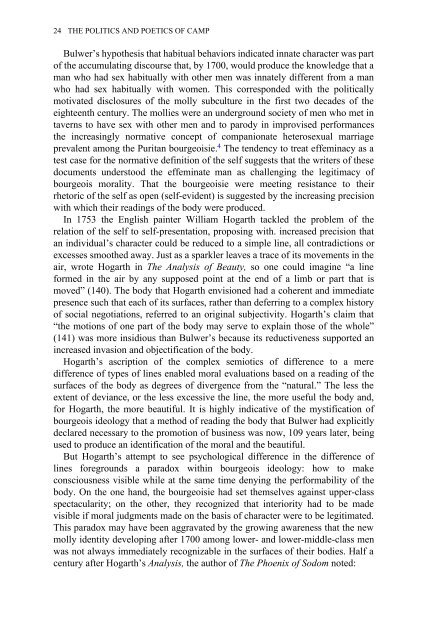Edited by Moe Meyer - Get a Free Blog
Edited by Moe Meyer - Get a Free Blog
Edited by Moe Meyer - Get a Free Blog
Create successful ePaper yourself
Turn your PDF publications into a flip-book with our unique Google optimized e-Paper software.
24 THE POLITICS AND POETICS OF CAMP<br />
Bulwer’s hypothesis that habitual behaviors indicated innate character was part<br />
of the accumulating discourse that, <strong>by</strong> 1700, would produce the knowledge that a<br />
man who had sex habitually with other men was innately different from a man<br />
who had sex habitually with women. This corresponded with the politically<br />
motivated disclosures of the molly subculture in the first two decades of the<br />
eighteenth century. The mollies were an underground society of men who met in<br />
taverns to have sex with other men and to parody in improvised performances<br />
the increasingly normative concept of companionate heterosexual marriage<br />
prevalent among the Puritan bourgeoisie. 4 The tendency to treat effeminacy as a<br />
test case for the normative definition of the self suggests that the writers of these<br />
documents understood the effeminate man as challenging the legitimacy of<br />
bourgeois morality. That the bourgeoisie were meeting resistance to their<br />
rhetoric of the self as open (self-evident) is suggested <strong>by</strong> the increasing precision<br />
with which their readings of the body were produced.<br />
In 1753 the English painter William Hogarth tackled the problem of the<br />
relation of the self to self-presentation, proposing with. increased precision that<br />
an individual’s character could be reduced to a simple line, all contradictions or<br />
excesses smoothed away. Just as a sparkler leaves a trace of its movements in the<br />
air, wrote Hogarth in The Analysis of Beauty, so one could imagine “a line<br />
formed in the air <strong>by</strong> any supposed point at the end of a limb or part that is<br />
moved” (140). The body that Hogarth envisioned had a coherent and immediate<br />
presence such that each of its surfaces, rather than deferring to a complex history<br />
of social negotiations, referred to an original subjectivity. Hogarth’s claim that<br />
“the motions of one part of the body may serve to explain those of the whole”<br />
(141) was more insidious than Bulwer’s because its reductiveness supported an<br />
increased invasion and objectification of the body.<br />
Hogarth’s ascription of the complex semiotics of difference to a mere<br />
difference of types of lines enabled moral evaluations based on a reading of the<br />
surfaces of the body as degrees of divergence from the “natural.” The less the<br />
extent of deviance, or the less excessive the line, the more useful the body and,<br />
for Hogarth, the more beautiful. It is highly indicative of the mystification of<br />
bourgeois ideology that a method of reading the body that Bulwer had explicitly<br />
declared necessary to the promotion of business was now, 109 years later, being<br />
used to produce an identification of the moral and the beautiful.<br />
But Hogarth’s attempt to see psychological difference in the difference of<br />
lines foregrounds a paradox within bourgeois ideology: how to make<br />
consciousness visible while at the same time denying the performability of the<br />
body. On the one hand, the bourgeoisie had set themselves against upper-class<br />
spectacularity; on the other, they recognized that interiority had to be made<br />
visible if moral judgments made on the basis of character were to be legitimated.<br />
This paradox may have been aggravated <strong>by</strong> the growing awareness that the new<br />
molly identity developing after 1700 among lower- and lower-middle-class men<br />
was not always immediately recognizable in the surfaces of their bodies. Half a<br />
century after Hogarth’s Analysis, the author of The Phoenix of Sodom noted:


